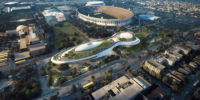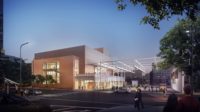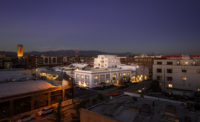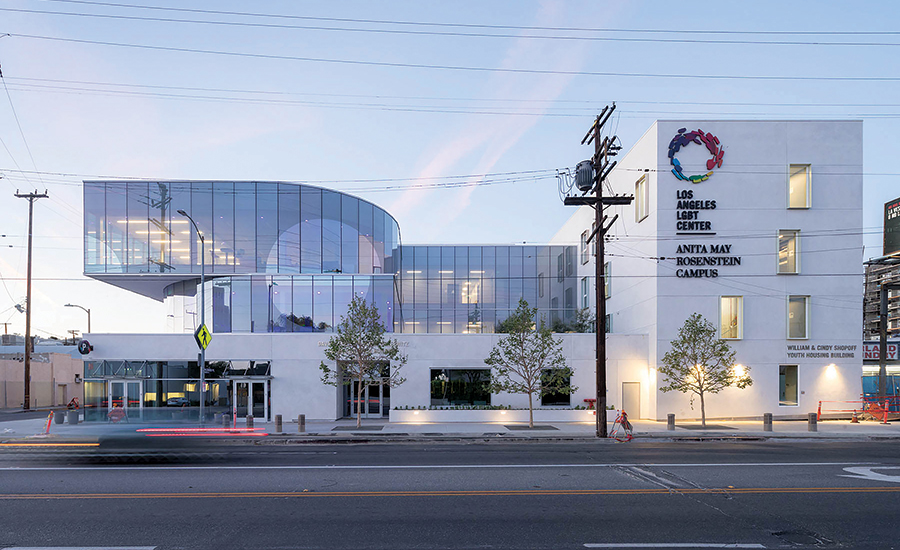Los Angeles LGBT Center Opens New Campus

From certain angles, cutouts in the frit align to form circles on the glazing.
Photo © Iwan Baan

Pride Hall opens to the main plaza.
Photo © Iwan Baan

Courtyards break up the building’s mass and infuse interiors with daylight.
Photo © Iwan Baan

The campus presents a distinct face to each side of its corner site.
Photo © Iwan Baan




Every year, June is Pride month, a festive time for the LGBTQ community and allies. But this year, June is especially notable: it marks the 50th anniversary of the Stonewall Uprising in New York—a landmark event in the history of LGBTQ rights. There’s even further cause for celebration at the Los Angeles LGBT Center, which is also turning 50 this year. Located in the heart of Hollywood, the Center’s $141 million new Anita May Rosenstein Campus has just opened, presenting a striking, dignified face to the neighborhood.
Designed by New York–based Leong Leong, a 2011 RECORD Design Vanguard winner, and Killefer Flammang Architects (KFA) in Los Angeles, the 70,000-square-foot building dramatically expands the Center’s capacity to serve the LGBTQ community. Rendered in white stucco and located across the street from an existing Center facility, the new building includes activity centers for youth and seniors, an educational and work-training academy for young people, event space, offices, and 100 beds for temporarily housing homeless youth. The firms also developed the master plan for the campus; Phase II, currently under construction and slated for completion in 2020, includes 98 units of affordable senior housing and 25 supportive apartments for young people.

Both the intergenerational nature of the Center’s clientele and the diversity of programs offered to them informed the design, says Dominic Leong, principal of the firm he founded with his brother Chris Leong in 2009. “We had to create a campus that negotiates this idea of cohesion and unity, but also holds space for differences and multiplicity.” A series of internal courtyards brings daylight to areas deep within the plan while buffering different program spaces from each other, yet also creating connections between them.
The main entrance and a flexible event space called Pride Hall are located just off a large plaza, which fronts the sidewalk and connects by elevator to underground parking. Five other entrances to the facility allow staff and visitors to enter through a door that gives them access to the program area—and level of privacy—they may desire. “It fits the Center’s mission to have multiple points of entry, so you feel welcome however you approach,” says KFA partner Barbara Flammang.
The massing and materials of the steel-frame building work to engage the project’s urban context. The building comprises volumes of two to four stories, keeping the senior and youth centers at a more intimate scale, while allowing staff offices and the temporary youth housing to become taller. Because function generated form, the building has a unique profile from each side: “There isn’t one singular, iconic point of view,” says Dominic. “We thought that was important, because the Center isn’t about the singular; it’s about multiplicity.” A frit pattern on the glazed upper stories adds to the lively street presence (while also reducing solar gain); from certain perspectives, oblong cutouts in the frit align to form circles, echoing the Center’s logo.
Creating a space for clients to feel safe, both physically and emotionally, was paramount to the Center and the designers, so security comes primarily in the form of on-site personnel, rather than an abundance of cameras or tightly controlled entrances and exits. “As an organization, the Center is very open, and they wanted that to be maintained in our design,” says Jesse Ottinger, the lead designer and project manager of KFA. “They’re very sensitive to the youth population and don’t want them to feel as if they were under surveillance, because many people come to the center after having traumatic experiences.”
The project is Leong Leong’s largest building to date. “It affirmed our belief that architecture is fundamentally about self-actualization,” says Dominic. “It’s about how we relate to ourselves and others, and how we create spaces that meet our needs as we evolve as individuals and as a society. Architecture can nudge us along that path, and this project was validation of that.”
KFA has operated in Los Angeles for some 40 years and, for their part, says Flammang, “If we can look back and say we’ve helped make the people who live here more comfortable, with access to the things that they need to live a good life, then we’ve done a good job.”







